Former Senator, Four Others Fatally Injured In August,
2010
The NTSB has released the factual data it will use to determine
the probable cause in an accident which occurred on August 9, 2010.
The accident fatally injured former Alaska Senator Ted Stevens and
four others, including the pilot. Four other people were seriously
injured when the airplane went down.
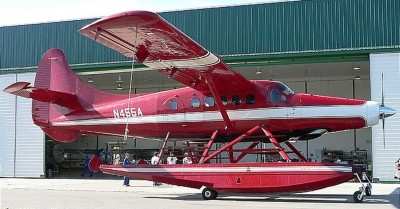
de Havilland DHC-3T N455A
According to the report, about 1442 Alaska daylight time (ADT),
a single engine, turbine-powered, amphibious float-equipped de
Havilland DHC-3T airplane, N455A, impacted mountainous tree-covered
terrain about 10 miles northeast of Aleknagik, Alaska. Of the nine
people aboard, the airline transport pilot and four passengers died
at the scene, and four passengers sustained serious injuries. The
airplane sustained substantial damage. The flight was operated by
General Communication, Incorporated (GCI), Anchorage, Alaska, under
the provisions of 14 Code of Federal Regulations (CFR) Part 91. The
flight originated at a GCI-owned remote fishing lodge on the
southwest shoreline of Lake Nerka about 1427 and was en route to a
remote sport fishing camp on the banks of the Nushagak River, about
52 miles southeast of the GCI lodge. At the time of the accident,
marginal visual meteorological conditions were reported at the
Dillingham Airport, about 18 miles south of the accident site;
however, the weather conditions at the accident site at that time
are not known. No flight plan was filed.
The NTSB Operations Group members convened at Anchorage, Alaska,
on August 10, 2010, to conduct the initial field phase of the
investigation. The Operations Group concluded the field phase of
the accident investigation in Anchorage, Alaska, on August 18,
2010.
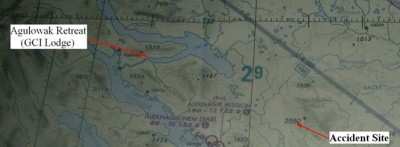
Accident Site On Sectional Chart
According to GCI Lodge personnel, the purpose of the flight was
to transport 8 passengers to the HRM fishing camp, which is located
about 52 nautical miles southeast of the GCI Lodge, for an
afternoon of fishing, followed by a return flight to the GCI Lodge
for dinner. Lodge personal reported that earlier in the morning
after the pilot had returned from Dillingham, he reported that the
weather consisted of turbulence and low ceilings and was not
conducive for a flight to the fishing camp at that time. However,
after finishing lunch, which was about 1400, the pilot informed the
lodge coordinator who was in charge of coordinating the flights to
the fishing camp, that the weather had lifted and he was
comfortable taking a group to the fishing camp if they wanted to
go. The coordinator reported that he gathered and organized the
guests, making sure that they all had their fishing licenses and
gear; he estimated that it took him between 20 to 30 minutes to get
the group to the dock. It was also reported that each occupant wore
life preservers on the airplane.
Prior to the airplane’s departure the lodge manager
reported observing the pilot checking the weather several times on
the computer. He said that after being informed that the group
would be going to the fishing camp, he called the fishing camp to
inform them that they had a group who hoped to go fishing; the
fishing camp replied, saying that they were speaking with the GCI
pilot and that they were ready for the lodge guests. The lodge
manager stated that he proceeded to the dock at about 1430 and
helped untie and push the airplane off the dock. He further stated
that at the time the Otter took off he could see all of Jackknife
Mountain across the lake, which he said is about 2,100 feet high
and that it was mostly cloudy but there were some blue patches in
the sky. The lodge manager added, “I could see all the way to
the end of the lake, so at least three miles. It was somewhat
windy.” In addition, the guest coordinator stated that as far
as the weather was concerned, he could see down the Agulowak River
to the bend, and in the other direction he could see across River
Bay. He said the cloud layer was “clipping”
approximately the top 25 percent of the mountain peaks across the
River Bay from the [GCI Lodge]. Sky Connect data revealed that the
airplane departed the lodge at about 1427. According to the lodge
manager, the group was expected back for dinner, which was normally
served at about 1900.
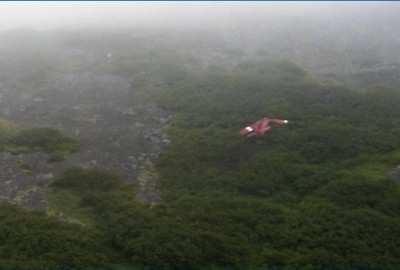
Accident Site Aerial Photo
The lodge coordinator reported that during the afternoon he was
working on his laptop and noticed that it was getting late. He
checked the cabins to see if anyone was back and then proceeded to
the lodge dining hall, where he noticed by the clock on the wall
that it was 1813. The lodge manager subsequently called the HRM
fishing camp to inquire about the status of the airplane, at which
time he was informed that the airplane had never arrived. He also
called the Dillingham Flight Service Station to inquire if they had
any information relative to the location of the airplane. The
briefer reported that he had not had any contact with the airplane
since it had departed earlier that morning.
At about 1830, two residents of the GCI lodge, one of whom was a
physician, departed in their private airplane on a search of the
area. Shortly thereafter, a GCI technician based in Dillingham,
which is located about 23 nautical miles southeast of the GCI
lodge, departed the Dillingham Airport (PADL) in a Robinson R-44
helicopter to join in the search of the overdue flight. According
to DLG FSS personnel, an Alert Notification (ALNOT) for N455A was
issued at 1916. Additionally, 2 Cessna 207 airplanes, which were
also operating in the area at the time, joined in the search. At
about 1935, the pilot of one of the Cessna 207s reported that he
had spotted N455A. Subsequently, FSS personnel provided the pilot
of the R-44 with the accident location, which resulted in the pilot
landing about 1,000 feet above the accident site. The GCI
technician deplaned the helicopter and proceeded to the site of the
wreckage. In coordination with the private airplane, which had
departed the GCI Lodge earlier to join in the search, the
helicopter pilot departed for the Aleknagik Airport, about 10 miles
southwest of the accident site, where he rendezvoused with the
physician in order to transport her to the accident site.
The GCI technician, who was the first responder, reported that
after being dropped off by the R-44 helicopter he proceeded down
slope to the airplane wreckage; he estimated this took between 20
to 30 minutes. After arriving at the wreckage the technician
remained at the site long enough to identify the survivors and
speak with them from outside of the airplane. The technician then
proceeded back up to the original helicopter landing zone to meet
with and assist the doctor down to the wreckage site; she had just
arrived from Aleknagik in the R-44. He stated that at this time the
R-44 pilot returned to Dillingham pick up and transport two
emergency medical technicians (EMTs) to the accident site. After a
period of time and while at the wreckage site with the doctor, the
GCI technician observed the R-44 helicopter returning from
Dillingham. Following an unsuccessful attempt to land at the
original landing site, the helicopter pilot landed successfully at
an alternative site. After securing the helicopter the pilot and
both EMTs proceeded to the wreckage site. Personnel now at the
scene of the accident included the doctor, the GCI technician, the
R-44 pilot, and the two EMTs from Dillingham.
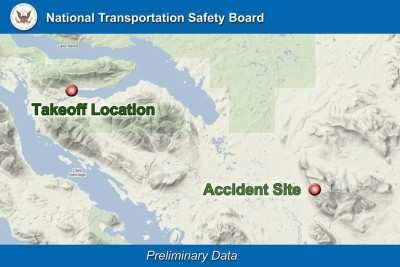
NTSB Map
At about 2030, Egli Air Haul of King Salmon, Alaska, was
contacted by GCI personnel to transport two EMTs based in
Dillingham to the accident site. Subsequently, an Egli Air Haul
Bell 206B helicopter departed King Salmon at 2041, and landed at
Dillingham at 2118, with the pilot and mechanic on board; the
mechanic is also an Alaska certified EMT-3. The EMT/mechanic
reported that they departed Dillingham at 2129 and arrived at the
accident site landing zone about 2140, where he and the other two
EMTs deplaned. The EMT-3/mechanic reported that he and the two EMTs
proceeded uphill, thinking this was the correct route to the
accident site; however, the location of the accident site from the
landing zone was downhill. The EMT-3 said that after about an hour
of looking for the wreckage, he advised the two Dillingham EMTs to
proceed back down the hill, as that might be the direction of the
wreckage. The EMT-3 said that a short time later he too proceeded
down the hill, but did not locate the two Dillingham EMTs before he
reach the helicopter landing zone. The EMT-3 reported that during
this time frame the Bell 206B helicopter pilot had departed the
landing zone to search for the crash site, and upon returning
picked up the EMT-3 and flew him to an area in close proximity to
the crash site; the two Dillingham EMTs had elected not to go on
this flight. After landing the EMT-3 proceeded about 100 yards to
the crash site, where he rendered aid and assistance to the
survivors and remained overnight. The EMT-3 reported that due to
the darkness, the fog, and injuries to the passengers, and that
removal was impossible at this time, he radioed the pilot of the
Bell 206B to return to Dillingham for the remainder of the
night.
The GCI technician stated that he had earlier observed the other
helicopter (the Bell 206B) land and drop off two EMTs and then saw
them proceed up hill, which prompted him and the R-44 pilot to
leave the wreckage site to look for them. The technician stated
that by the time they did locate the EMTs, it was about 2330, and
they were near the landing zone where the R-44 helicopter was
located. The GCI technician revealed that the group ultimately
decided that it was too dangerous to try and get back down to the
accident site, so they departed for Dillingham in the R44. The
technician said that he thought it was around midnight when they
arrived at Dillingham.
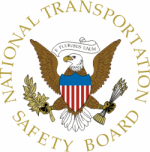
A post accident examination of the wreckage site revealed that
the airplane had impacted upsloping terrain with an estimated
incline of about 30 degrees. The airplane came to rest on a
magnetic heading of 070 degrees at an altitude of about 900 feet,
and at coordinates 59 degrees 19.43 minutes north latitude and 158
degrees 23.25 minutes west longitude. The energy path was estimated
to cover a distance of about 150 feet. The wreckage site about 18
miles southeast of the GCI Lodge and about 32 miles northwest of
the HRM fishing camp. Search and rescue operations were successful
in extracting the 4 surviving passengers from the wreckage site the
morning following the accident. Subsequently,the airplane’s
wreckage was recovered to a secured facility in Dillingham for
further examination.
 Aero-News: Quote of the Day (04.28.25)
Aero-News: Quote of the Day (04.28.25) ANN's Daily Aero-Term (04.28.25): Decision Altitude (DA)
ANN's Daily Aero-Term (04.28.25): Decision Altitude (DA) ANN's Daily Aero-Linx (04.28.25)
ANN's Daily Aero-Linx (04.28.25) Airborne-Flight Training 04.24.25: GA Refocused, Seminole/Epic, WestJet v TFWP
Airborne-Flight Training 04.24.25: GA Refocused, Seminole/Epic, WestJet v TFWP Aero-News: Quote of the Day (04.29.25)
Aero-News: Quote of the Day (04.29.25)







